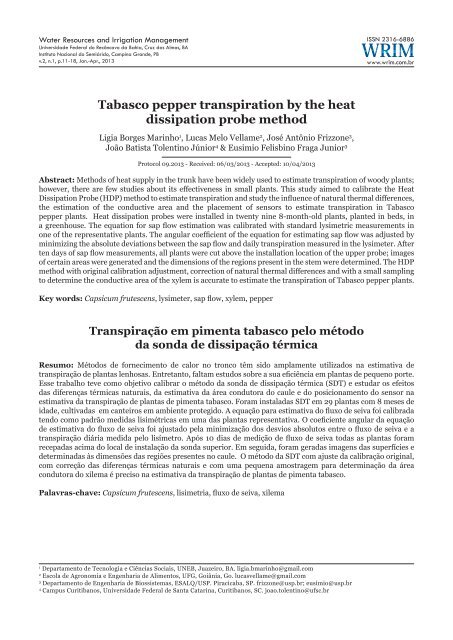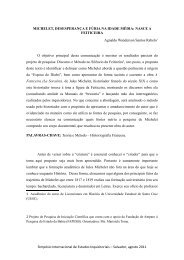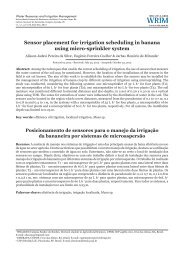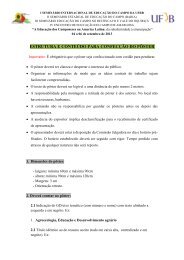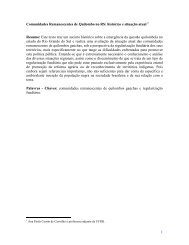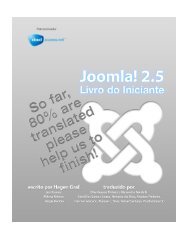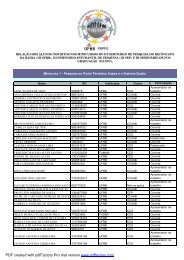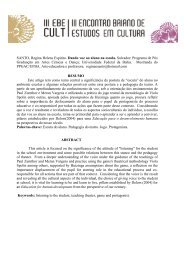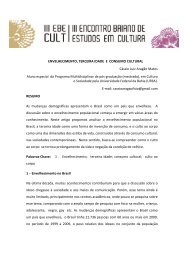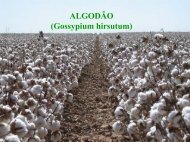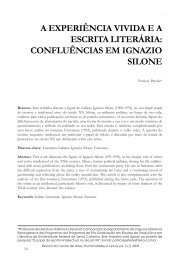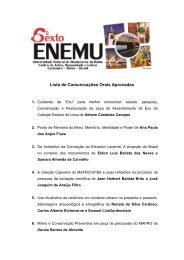Tabasco pepper transpiration by the heat dissipation probe ... - UFRB
Tabasco pepper transpiration by the heat dissipation probe ... - UFRB
Tabasco pepper transpiration by the heat dissipation probe ... - UFRB
Create successful ePaper yourself
Turn your PDF publications into a flip-book with our unique Google optimized e-Paper software.
Water Resources and Irrigation ManagementUniversidade Federal do Recôncavo da Bahia, Cruz das Almas, BAInstituto Nacional do Semiárido, Campina Grande, PBv.2, n.1, p.11-18, Jan.-Apr., 2013ISSN 2316-6886www.wrim.com.br<strong>Tabasco</strong> <strong>pepper</strong> <strong>transpiration</strong> <strong>by</strong> <strong>the</strong> <strong>heat</strong><strong>dissipation</strong> <strong>probe</strong> methodLigia Borges Marinho 1 , Lucas Melo Vellame 2 , José Antônio Frizzone 3 ,João Batista Tolentino Júnior 4 & Eusimio Felisbino Fraga Junior 3Protocol 09.2013 - Received: 06/03/2013 - Accepted: 10/04/2013Abstract: Methods of <strong>heat</strong> supply in <strong>the</strong> trunk have been widely used to estimate <strong>transpiration</strong> of woody plants;however, <strong>the</strong>re are few studies about its effectiveness in small plants. This study aimed to calibrate <strong>the</strong> HeatDissipation Probe (HDP) method to estimate <strong>transpiration</strong> and study <strong>the</strong> influence of natural <strong>the</strong>rmal differences,<strong>the</strong> estimation of <strong>the</strong> conductive area and <strong>the</strong> placement of sensors to estimate <strong>transpiration</strong> in <strong>Tabasco</strong><strong>pepper</strong> plants. Heat <strong>dissipation</strong> <strong>probe</strong>s were installed in twenty nine 8-month-old plants, planted in beds, ina greenhouse. The equation for sap flow estimation was calibrated with standard lysimetric measurements inone of <strong>the</strong> representative plants. The angular coefficient of <strong>the</strong> equation for estimating sap flow was adjusted <strong>by</strong>minimizing <strong>the</strong> absolute deviations between <strong>the</strong> sap flow and daily <strong>transpiration</strong> measured in <strong>the</strong> lysimeter. Afterten days of sap flow measurements, all plants were cut above <strong>the</strong> installation location of <strong>the</strong> upper <strong>probe</strong>; imagesof certain areas were generated and <strong>the</strong> dimensions of <strong>the</strong> regions present in <strong>the</strong> stem were determined. The HDPmethod with original calibration adjustment, correction of natural <strong>the</strong>rmal differences and with a small samplingto determine <strong>the</strong> conductive area of <strong>the</strong> xylem is accurate to estimate <strong>the</strong> <strong>transpiration</strong> of <strong>Tabasco</strong> <strong>pepper</strong> plants.Key words: Capsicum frutescens, lysimeter, sap flow, xylem, <strong>pepper</strong>Transpiração em pimenta tabasco pelo métododa sonda de dissipação térmicaResumo: Métodos de fornecimento de calor no tronco têm sido amplamente utilizados na estimativa detranspiração de plantas lenhosas. Entretanto, faltam estudos sobre a sua eficiência em plantas de pequeno porte.Esse trabalho teve como objetivo calibrar o método da sonda de dissipação térmica (SDT) e estudar os efeitosdas diferenças térmicas naturais, da estimativa da área condutora do caule e do posicionamento do sensor naestimativa da transpiração de plantas de pimenta tabasco. Foram instaladas SDT em 29 plantas com 8 meses deidade, cultivadas em canteiros em ambiente protegido. A equação para estimativa do fluxo de seiva foi calibradatendo como padrão medidas lisimétricas em uma das plantas representativa. O coeficiente angular da equaçãode estimativa do fluxo de seiva foi ajustado pela minimização dos desvios absolutos entre o fluxo de seiva e atranspiração diária medida pelo lisímetro. Após 10 dias de medição de fluxo de seiva todas as plantas foramrecepadas acima do local de instalação da sonda superior. Em seguida, foram geradas imagens das superfícies edeterminadas às dimensões das regiões presentes no caule. O método da SDT com ajuste da calibração original,com correção das diferenças térmicas naturais e com uma pequena amostragem para determinação da áreacondutora do xilema é preciso na estimativa da transpiração de plantas de pimenta tabasco.Palavras-chave: Capsicum frutescens, lisimetria, fluxo de seiva, xilema1Departamento de Tecnologia e Ciências Sociais, UNEB, Juazeiro, BA. ligia.bmarinho@gmail.com2Escola de Agronomia e Engenharia de Alimentos, UFG, Goiânia, Go. lucasvellame@gmail.com3Departamento de Engenharia de Biossistemas, ESALQ/USP. Piracicaba, SP. frizzone@usp.br; eusimio@usp.br4Campus Curitibanos, Universidade Federal de Santa Catarina, Curitibanos, SC. joao.tolentino@ufsc.br
12Marinho et al.IntroductionThe increase in conflicts between sectors thatuse <strong>the</strong> water resources, <strong>the</strong> charging for wateruse and <strong>the</strong> commercial demand for certifiedproducts, derived from a sustainable agriculturalactivity, have increased <strong>the</strong> importance of efficientirrigation. Localized irrigation is a very efficientirrigation system, since <strong>the</strong> applied volume ofwater is small and restricted to a portion of <strong>the</strong>soil, reducing losses <strong>by</strong> evaporation and runoff.Since losses are reduced in localized irrigationsystems, <strong>transpiration</strong> becomes <strong>the</strong> principalfactor to be determined for water management.Advances in <strong>the</strong> use and development ofsap flow estimation techniques were observedthroughout <strong>the</strong> years. These techniques canbe used to quantify <strong>the</strong> <strong>transpiration</strong> and <strong>the</strong>water relations of various crops under differentirrigation regimes, with salty water or even underbiotic and abiotic stresses. Most of <strong>the</strong> studiesabout plant <strong>transpiration</strong>, especially in woodyplants, are based on methods of <strong>heat</strong> supply in<strong>the</strong> trunk. Nowadays, <strong>the</strong>re are three groups ofsystems to determine sap flow: <strong>heat</strong> pulse, <strong>heat</strong>balance and <strong>heat</strong> <strong>dissipation</strong> (Green et al., 2003;Davis et al., 2012; Renninger & Schäfer, 2012)The <strong>heat</strong> <strong>dissipation</strong> <strong>probe</strong> (HDP) methoddeveloped <strong>by</strong> Granier (1985) presents a simple<strong>the</strong>oretical approach and, compared to <strong>the</strong> <strong>heat</strong>balance method, shows <strong>the</strong> advantages of facilityto build and install <strong>the</strong> sensors, lower cost and <strong>the</strong>need for fewer channels in <strong>the</strong> data acquisitionsystem, enabling <strong>the</strong> monitoring of a highernumber of plants in <strong>the</strong> field. It has shown to be apromising method, being largely used worldwide(Sugiura et al., 2009; Ford et al., 2004; Gartineret al., 2009; Gebauer et al., 2008) . In Brazil, itsuse has been reported in studies of estimation of<strong>transpiration</strong> in crops such as “Valência” orange(Vellame et al., 2012); coffee tree (Pimentel et al.,2010); mango tree (Vellame et al., 2009); rubbertree, a latex-producing tree (Delgado-Rojaset al., 2006) and also in <strong>the</strong> determination ofwater regulation strategy of Rapanea guianensisand Roupala Montana, woody species from‘Cerrado’, under water deficit conditions (Naves-Barbiero et al., 2000). These studies indicate<strong>the</strong> possibility of utilization of this method withpositive results.However, <strong>the</strong> HDP method shows sources oferror related to <strong>the</strong> natural <strong>the</strong>rmal differences,<strong>the</strong> spatial distribution of <strong>the</strong> sap flow in <strong>the</strong> stem,<strong>the</strong> setting of <strong>the</strong> conductive area (<strong>the</strong> transversalarea occupied <strong>by</strong> <strong>the</strong> xylem) and <strong>the</strong> installationposition of <strong>the</strong> sensors on <strong>the</strong> stem. The areaconducting sap varies according to <strong>the</strong> species,age and stem diameter of <strong>the</strong> plant. The setting of<strong>the</strong> conductive area is a limitation of <strong>the</strong> methodbecause it demands <strong>the</strong> plant to be destroyed for<strong>the</strong> measurement. Thus, it is possible to correlate<strong>the</strong> sap conductive area with <strong>the</strong> external diameter;however, this information is not available in<strong>the</strong> literature for most crops and must be betterstudied.There is also little research on <strong>the</strong> influence of<strong>the</strong> sensor position on <strong>the</strong> stem, its applicationfor estimating <strong>transpiration</strong> and water relationsin smaller-sized woody plants, like <strong>pepper</strong> plants.This crop has been highlighted as an importantproduct of Brazilian agribusiness, generatingemployment and income for farmers in <strong>the</strong> ruralareas (Miranda et al., 2006).This work aimed at calibrating <strong>the</strong> <strong>heat</strong><strong>dissipation</strong> <strong>probe</strong> method studying <strong>the</strong> effectsof natural <strong>the</strong>rmal differences, stem conductivearea and sensor positioning for estimating<strong>transpiration</strong> of <strong>Tabasco</strong> <strong>pepper</strong> plants.Material and MethodsThe experiment was carried out in a greenhouse,in <strong>the</strong> Biosystem Engineering Department of “Luizde Queiroz” College of Agriculture – ESALQ-USP,Piracicaba, São Paulo, 22 0 42’30” S and 47 0 38’00”W, at 580 m of altitude, from 20 th July to 5 thAugust, 2010.In this study three arched, east-west orientedgreenhouses were used (Ceiling height – 3.0m; Width – 7.1 m; Length – 17.64 m; and TotalHeight – 4.7 m). The greenhouses had a 150 µmtransparent polyethylene plastic cover, and frontand side walls made with anti-aphid net with a0.3-m-high bottom part made of concrete. Sapflow was measured using <strong>the</strong> HDP method in 29tabasco <strong>pepper</strong> plants at <strong>the</strong> age of 8 months (227days after transplanting) after a production cycleand a period of irrigation.Each sensor was comprised of a <strong>probe</strong> <strong>heat</strong>ed atconstant power and a non-<strong>heat</strong>ed <strong>probe</strong> (reference<strong>probe</strong>), both having internally a <strong>the</strong>rmocouple(Figure 1). The power applied to <strong>the</strong> <strong>heat</strong>ed <strong>probe</strong>followed <strong>the</strong> literature - 0.1 W cm -1 on <strong>probe</strong> length(Delgado-Rojas, 2003). Adjustable current sourcewere built in order to control <strong>the</strong> power dissipatedin each sensor.Granier (1985) correlated <strong>the</strong> sap flow densityand <strong>the</strong> <strong>the</strong>rmal difference between both <strong>probe</strong>s,validating his equation (Eq. 1) for some species,in special forest plants: Pinusnigra, PseudotsugaWater Resources and Irrigation Management, v.2, n.1, p.11-18, 2013.
16Marinho et al.Figure 7. Relationship between <strong>the</strong> average daily sapflow period (FS) for each plant with and without compensationof <strong>the</strong> natural temperature differences in <strong>the</strong>stem - NTD (A) and relationship between <strong>the</strong> lysimetermeasured and cumulative daily sap flow with and withoutNTD compensation (B)The mean values of sap flow estimated <strong>by</strong> Eq.(7), with and without compensation for NTD, arecorrelated in Figure 7A. There is a strong trendof underestimation in <strong>the</strong> method when NTD arenot compensated (average of 14.9%). Vellame etal. (2011) found underestimation trends of 13.15%for sap flow in adult mango trees, using <strong>the</strong> <strong>heat</strong><strong>dissipation</strong> <strong>probe</strong> method.When <strong>the</strong>rmal differences are corrected<strong>by</strong> subtracting <strong>the</strong> estimated natural <strong>the</strong>rmaldifferences, <strong>the</strong> trend of underestimating <strong>the</strong>flow <strong>by</strong> <strong>the</strong> method decreases and <strong>the</strong> accuracy inestimating <strong>the</strong> sap flow increases, as one can see<strong>by</strong> <strong>the</strong> increase of <strong>the</strong> determination coefficient(R 2 ) shown in Figure 7B.Delgado-Rojas (2003) and Delgado-Rojaset al. (2004) found, in coffee and lemon plants,respectively, that <strong>the</strong> mentioned gradient showshigh interference on <strong>the</strong> estimations.Girardi et al. (2010) noted that errorsinherent to <strong>the</strong> NTD and injuries in <strong>the</strong> stemtissues affected <strong>the</strong> accuracy of <strong>the</strong> sap flowmeasurements, with <strong>the</strong> <strong>heat</strong> <strong>dissipation</strong> <strong>probe</strong>method of “Valência” orange tree (Citrussinensis (L.) Osbeck) grafted on “Cravo” lemon(Citrus limonia Osbeck). However, Delgado-Rojas et al. (2006), studying rubber trees,verified no interference of NTD on <strong>the</strong> sap flowestimations (Fs) due to <strong>the</strong> closure of plantcanopy, resulting in nearly 100% shading.According to <strong>the</strong>se authors, it seems that whenplants have a low basal area (young plants) orlow population density, <strong>the</strong>re may be a higherincidence of <strong>the</strong>rmal load from <strong>the</strong> environmenton <strong>the</strong>m, suffering more easily with <strong>the</strong>interference of natural <strong>the</strong>rmal gradient (NTD).Also, <strong>the</strong> smaller <strong>the</strong> plants <strong>the</strong> stronger <strong>the</strong>effects, especially because of <strong>the</strong> reduced stemdiameter, thus more easily affected, both for<strong>the</strong> energy transferred <strong>by</strong> advection and for <strong>the</strong>energy transformed on that place.The xylem and supporting structures(conductive area) occupied an area of 70.9%,medulla, 9.5% and epidermis, cortex, fibers andphloem, 19.6% of <strong>the</strong> total stem area of <strong>Tabasco</strong><strong>pepper</strong> plant.The relation between <strong>the</strong> conductive sectionarea and <strong>the</strong> outer perimeter of <strong>the</strong> stem had a goodadjustment following a quadratic polynomial, Eq.(8).2 2AS = 0. 112P − 0. 819P+ 2. 765 R = 0.991in which,AS - area of <strong>the</strong> conductive section, cm 2P - outer perimeter of <strong>the</strong> stem, cmIn this study, using all <strong>the</strong> plants as destructivesamples, it was possible to establish <strong>the</strong> numberof sampled stems that allows a reliable estimationof <strong>the</strong> active xylem area.With a small sampling (around 10% or 3 stemsegments) <strong>the</strong> errors are smaller than 5%, whichallows studies of this nature with a reducednumber of destroyed plants (Figure 8).Figure 8. Percentage error in <strong>the</strong> relationship betweenmeasured and estimated conductive area (ASest/ASmed)versus percentage of stems sampled(8)The coefficients of variation (CV) for <strong>the</strong>daily measurements of sap flow from <strong>the</strong> 29plants with and without correction to <strong>the</strong> sensorpositioning <strong>by</strong> Eq. (6) may be seen in Figure 9.It is noted that part of <strong>the</strong> variability of <strong>the</strong> dailymeasurements of sap flow between plants canbe explained <strong>by</strong> <strong>the</strong> positioning of <strong>the</strong> sensorin areas not conducting raw sap. For <strong>the</strong> entireperiod, <strong>the</strong> difference between CV values of <strong>the</strong>Water Resources and Irrigation Management, v.2, n.1, p.11-18, 2013.
<strong>Tabasco</strong> <strong>pepper</strong> <strong>transpiration</strong> <strong>by</strong> <strong>the</strong> <strong>heat</strong> <strong>dissipation</strong> <strong>probe</strong> method 17Laboratório de Anatomia Vegetal of <strong>the</strong> EscolaSuperior de Agricultura ‘Luiz de Queiroz’ – USP,for <strong>the</strong> identification of <strong>the</strong> stem structures of<strong>Tabasco</strong> <strong>pepper</strong>.Literature CitedFigure 9. Coefficient of variation of daily measurementsof sap flow in <strong>Tabasco</strong> <strong>pepper</strong> with and withoutcorrection of <strong>the</strong> effect of positioning <strong>the</strong> <strong>probe</strong>measurements with and without correctionwas of 5.3%, which explains only 12.5% of <strong>the</strong>variabilityConclusions1. Granier equation calibrated to <strong>Tabasco</strong><strong>pepper</strong> (F=0.000353 k 1.231 AS) with correction of<strong>the</strong> natural <strong>the</strong>rmal differences in <strong>the</strong> stem wasefficient to estimate <strong>transpiration</strong> (mean absolutedeviation smaller than 7% and R 2 coefficient of0.92), indicating great accuracy of <strong>the</strong> methodand possibility of its utilization in studies of waterrelations in conditions similar to those in thisstudy.2. The estimation of <strong>the</strong> conductive sectionarea as a function of <strong>the</strong> outer perimeter of <strong>the</strong>stem and <strong>the</strong> adopted sensor <strong>probe</strong> positioningwas satisfactory for <strong>the</strong> calibration of <strong>the</strong> <strong>heat</strong><strong>dissipation</strong> <strong>probe</strong> method for <strong>Tabasco</strong> <strong>pepper</strong>.3. The positioning of <strong>the</strong> <strong>heat</strong> <strong>dissipation</strong>sensor <strong>probe</strong> in areas not conducting raw sapwas responsible for part of <strong>the</strong> variability in <strong>the</strong>estimations of sap flow in <strong>Tabasco</strong> <strong>pepper</strong> plants,which highlights <strong>the</strong> influence of its location as asource of error in <strong>the</strong> HDP method.4. Sampling 10% of <strong>the</strong> <strong>Tabasco</strong> <strong>pepper</strong> stemsfor measuring <strong>the</strong> actual sap conductive area wasenough to establish a reliable estimation of <strong>the</strong>active xylem area, with errors smaller than 5%,allowing studies of this nature with a reducednumber of destroyed plants.AcknowledgementsThe authors wish to thank Ministério daCiência e Tecnologia (MCT), Conselho Nacionalde Desenvolvimento Científico e Tecnológico(CNPq) and Fundação de Amparo à Pesquisado Estado de São Paulo (FAPESP), for <strong>the</strong>financial support to conduct this study, through<strong>the</strong> Instituto Nacional de Ciência e Tecnologiaem Engenharia da Irrigação (INCTEI); and <strong>the</strong>Angelocci, L. R. A planta e trocas gasosas/energéticas com a atmosfera: Introdução aotratamento biofísico. Piracicaba: Luiz RobertoAngelocci, 2002. 268p.Coelho, R. D; Vellame, L. M.; Fraga Junior, E. F.Estimation of <strong>transpiration</strong> of <strong>the</strong> 'Valência'orange young plant using <strong>the</strong>rmal <strong>dissipation</strong><strong>probe</strong> method. Engenharia Agrícola, v.32,p.573-581, 2012.Davis, T. W.; Kuo, C. M.; Liang, X.; Yu, P. S. Sapflow sensors: Construction, quality control andcomparison. Sensors, v.12, p.954-971, 2012.Delgado-Rojas, J. S. Avaliação do uso do fluxode seiva e da variação do diâmetro do caulee de ramos na determinação das condiçõeshídricas de citros, como base para o manejode irrigação. Piracicaba: ESALQ/USP. 2003.110p. Tese DoutoradoDelgado-Rojas, J. S.; Angelocci, L. R.; Folegatti, M.V. ; Coelho Filho, M. A. Desempenho da sondade dissipação térmica na medida da transpiraçãode plantas jovens de Lima Ácida. EngenhariaAgrícola, v.27, p.404-413, 2007.Delgado-Rojas, J. S.; Highi, C. A.; Karasawa, S.;Angelocci, L. R.; Bernardes, M. S.; Folegatti,M. V. Desempenho da sonda de dissipaçãotérmica na medida do fluxo de seiva emseringueira, Engenharia Agrícola, v.26, p.722-729, 2006.Delgado-Rojas, J. S.; Karasawa, S.; Angelocci, L.R. Determinación de la transpiración del café(Coffea arabica L.) através del método de sondade disipación térmica. In: Reunión Argentina,5., Latino Americana de Agrometeorologia,9., 2004, La Plata. Anais... Buenos Aires:Asociación Argentina de Agrometeorologia,2004. CD-Rom.Ford, C. R.; McGuire, M. A.; Mitchell, R. J.;Teskey, R. O. Assessing variation in <strong>the</strong> radialprofile of sap flux density in Pinus species andits effect on daily water use. Tree Physiology,v.24, p.241–249, 2004.Gartiner, K.; Nadezhdina, N.; Englisch, M.;Cermak, J.; Leitgeb, E. Sap flow of birch andNorway spruce during <strong>the</strong> European <strong>heat</strong> anddrought in summer 2003. Forest Ecology andManagement, v.258, p.590-599, 2009.Water Resources and Irrigation Management, v.2, n.1, p.11-18, 2013.
18Marinho et al.Gebauer, T.; Horna, V.; Leuschner, C. Variabilityin radial sap flux density patterns and sapwoodarea among seven co-occurring temperatebroad-leaved tree species. Tree Physiology,v.28, p.1821–1830, 2008.Girardi, E. A.; Mourão Filho, F. de A. A.; Delgado-Rojas, J. S. ; Araújo, J. P. de C. Use of <strong>the</strong> <strong>heat</strong><strong>dissipation</strong> method for sap flow measurementin citrus nursery trees. Revista Brasileira deFruticultura, v.32, p.976-983, 2010.González-Altozano, P.; Pavel, E. W.; Oncins, J. A.;Doltra, J.; Cohen, M.; Paço, T.; Massai, R.; Castel,J. R. Comparative as sessment of five methodsof determining sap flow in peach trees.Agricultural Water Management, v.95, p.503-515, 2008.Granier, A. Une nouvelle methode pour la measuredu flux de seve brute dans le tronc des arbres.Annales Sciences Forestieres, v.42, p.193-200,1985.Green, S., Clothier, B., Jardine, B. Theory andpractical application of <strong>heat</strong> pulse to measuresap flow. Agronomy Journal, v.95, p.1371-1379,2003.Miranda, F. R; Gondim, R. S.; Costa, C. A. G.Evapo<strong>transpiration</strong> and crop coefficients fortabasco <strong>pepper</strong> (Capsicum frutescens L.)Agricultural Water Management, v.82, p.237-246, 2006.Naves-Barbiero, C. C.; Franco, A. C.; Bucci, S.J.; Goldstein, G. Fluxo de seiva e condutânciaestomática de duas espécies lenhosas sempreverdesno campo sujo e cerradão. RevistaBrasileira de Fisiologia Vegetal, v.12, p.119-134, 2000.Pimentel, J. da S.; Silva, T. J. A.; Borges Junior,J. C. F.; Folegatti, M. V.; Montenegro, A. A.A. Estimativa da transpiração em cafeeirosutilizando-se sensores de dissipação térmica.Revista Brasileira de Engenharia Agrícola eAmbiental, v.14, p.187–195, 2010.Renninger, H. J.; Schäfer, K. V. R. Comparison oftissue <strong>heat</strong> balance and <strong>the</strong>rmal <strong>dissipation</strong>derivedsap flow measurements in ring-porousoaks and a pine. Frontiers in Plant Science, v.3,p.1-8, 2012.Shackel, L. A.; Ahmadi, H.; Biasi, W. Plantwater status as an index of irrigation needin deciduos fruit tree.Hort Technology, v.7,p.23-29, 1997.Sugiura, H.; Sakamoto, D.; Sugiura, T.; Asakura, T.;Moriguchi, T. Evaluation of <strong>the</strong> use of <strong>the</strong> Graniersap flow method in japanese pear <strong>by</strong> comparisonwith <strong>transpiration</strong> <strong>by</strong> <strong>the</strong> weighing method. ActaHorticulturae, n.846, p.121-126, 2009.Vellame, L. M.; Coelho Filho, M. A.; Paz, V. P.S. Transpiração em mangueira pelo métodoGranier. Revista Brasileira de EngenhariaAgrícola e Ambiental, v.13, p.516–523, 2009.Vellame, L. M.; Coelho Filho, M. A.; Paz, V. P.S.; Coelho, E. F. Gradientes térmicos naturaisna estimativa do fluxo de seiva pelo métodoGranier. Revista Caatinga, v.24, p.116-122,2011.Vellame, L. M.; Tolentino, J. B.; Coelho, R. D.Transpiração de plantas jovens de laranjeira'Valência' sob porta-enxerto limão 'Cravo'e citrumelo 'Swingle' em dois tipos de solo.Revista Brasileira de Fruticultura, v.34, p.24-32, 2012.Water Resources and Irrigation Management, v.2, n.1, p.11-18, 2013.


